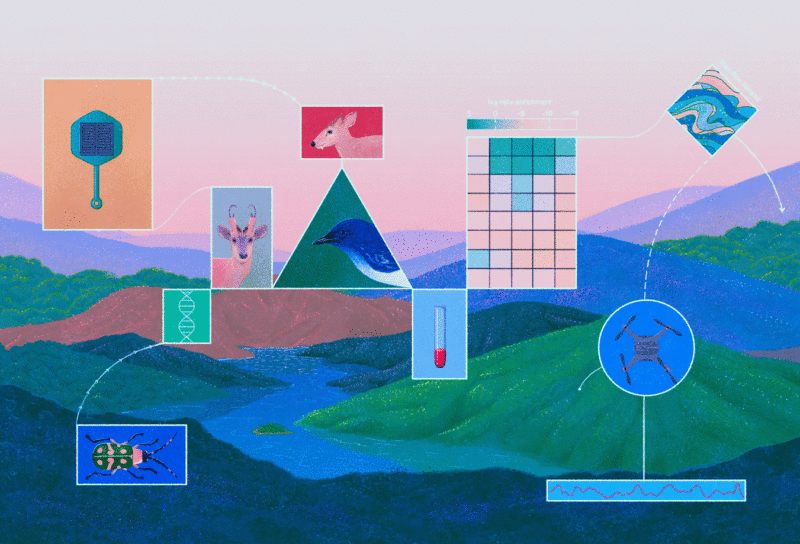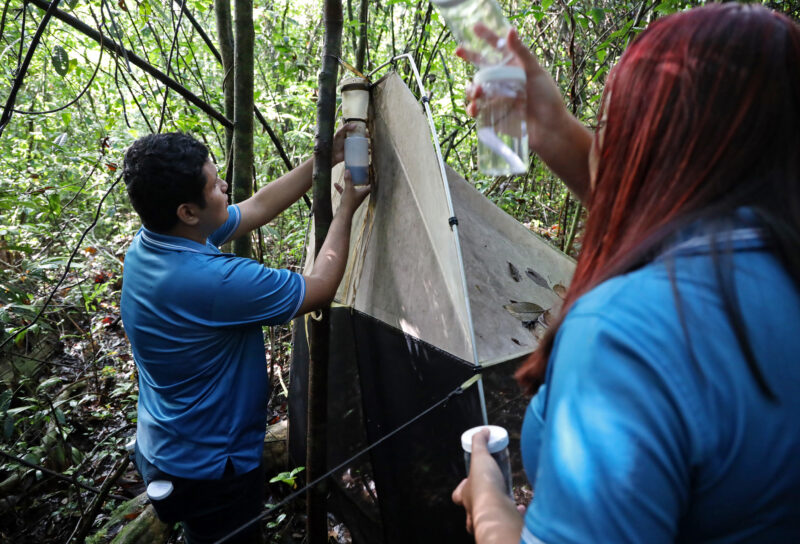In spring 2020, as the COVID pandemic spread across the United States, a new technological system focused its watchful gaze on humankind’s most elemental output —our poop. Just outside of Tempe, Arizona, wastewater operators and researchers pulled samples from the gutter of a small town called Guadalupe, scanning for fragments of SARS-CoV-2 genomic material. Though this method can’t diagnose individual people or count cases, according to Rolf Halden, director of the Biodesign Center for Environmental Health Engineering at Arizona State University, it sure is good at predicting surges.
Four years ago, Halden and his colleagues started using the same technology to monitor opioid levels — hoping to better understand how drugs were impacting local ecology. During the pandemic, the researchers pivoted to searching for traces of COVID instead. In May 2020, Halden was first to notice that Guadalupe was becoming a COVID hotspot. “This cluster was undetected, and we saw it in the wastewater,” he says. The town mobilized all its resources: dispatching masks, testing, and quarantine orders. Thanks to that head start, Guadalupe’s SARS-CoV-2 levels fell below detection limits in a matter of weeks. They flattened the curve before most residents even knew there was one.
This, unfortunately, is a rare success story. On a policy and implementation level, the current crisis has often revealed a tendency to react and a reluctance to prevent — a need for fundamental changes, but a preference for minor fixes. Driven by political and fiscal considerations, this order of operations has not only extended this pandemic, but in fact makes us much more vulnerable to future replays.
What to do? Speaking to a host of pandemic experts, a clear directive emerges. Pandemic preparedness is one area where future success depends crucially on learning the lessons from the past. Our ancestors were forced by mass outbreaks of disease to transform their societies to be less hospitable to contagion. The soundness of their specific choices determined whether they mourned their dead and rebuilt their lives, or suffered through another pandemic shortly after.
These failures and successes should inspire something within us — a new appetite for systemic change and structural solutions, like Guadalupe’s wastewater alarm system, that may just help future-proof our world against another tragic contagion.
Memorials & Facilities
Every day, whether you notice or not, you are surrounded by the relics of disease outbreaks from centuries ago. These mass biological events fundamentally reshaped our living environments and habits. In the 19th century, cholera tore through our cities, bringing death and a new burst of scientific information. At the time, the public still imagined disease as spread through miasma, meaning “bad air” or “night air.” It supposedly bubbled up from soil, swamps, sores and slums. Society adapted accordingly. Cities cleaned their streets and established new standards of hygiene. Avenues widened. Indoor plumbing standardized. More expansive public spaces appeared to free urbanites from the vapors. Frederick Law Olmsted designed New York’s Central Park as “the lungs of the city” with miasma in mind.
After bubonic plague came to San Francisco around 1900, germ theory primed policymakers to consider its nonhuman “zoonotic” hosts. They targeted rats. New city ordinances replaced rodent-friendly materials like wood and dirt with cement. Piers, sidewalks, basements, backyard chicken coops got facelifts. With the hygienic trends that debuted in the 19th century, “We rebuilt the physical environment,” says Elena Conis, a historian of medicine, public health, and environment at UC Berkeley. “We started to make a concrete city.” And that concrete made it sturdier and more attractive to tourists and investors.
“Every norm-shifting epidemic or pandemic leaves its mark,” says Conis. “Some of those marks actually are profoundly shaped by early misconceptions about what was causing the disease to spread out of control.” In the early 1880s, germ theory replaced miasma in the public imagination. By the late 19th century, the public came to understand tuberculosis as an airborne germ — meaning that whatever spewed from an infected person’s lungs could spread it. An anti-spitting campaign erupted in the U.S. and it stuck. “People don’t spit in public in the U.S. anymore,” says Conis. “You can trace this all the way back to the anti-tuberculosis campaigns.”
Each disease that followed brought with it new ideas of how to fight back. Got a plague problem? Here’s some concrete. Malarial parasites spread from mosquito bites? Here’s some pesticide, window screens, and bed nets. The human immunodeficiency virus spreads from sex? Here’s some PSAs, condoms, and prophylaxis. Coronavirus is spread through close contact? Here’s some masks, contact tracing apps, and 15-minute diagnostic tests. These new habits, too, endure long after the threat recedes.
The way that we choose to think about diseases informs how we interpret the very idea of responsiveness. Misconceptions about how animal viruses “spill over” into humans, for example, have primed people to think that pandemic control should be reactive, rather than predictive. “Understanding how spillovers happen,” says Emily Gurley, an epidemiologist at Johns Hopkins, “that’s the missing part that we’re just not doing enough.” Some strategies for disease prevention stick around and become a part of the broader culture, like safe sex — or contactless Taco Bell delivery. Others can’t boast the luxury of instant cause-and-effect, or a seductive profit margin. These lessons get left behind. “Pandemics create panic. And in a panic, you want to protect yourself, your family, your loved ones, your community, your state, your nation today,” Conis says. “You’re not thinking about 20 years down the line.”
It’s the unprofitable, unsexy science coming out of this pandemic that yields the best advice for stopping the next one in its tracks. As COVID teeters between pandemic waves and endemic burden, the acute panic has subsided. Public health’s mainstream moment is waning. And experts warn that the hope for most precious, evidence-backed remedies are disappearing alongside it.
We predicted it every time. You just didn’t listen.
Spillover
The misconceptions we have about pandemics begin with how they start. Yes, wild animals like bats carry viruses that can infect humans. Researchers deduced in early February 2020 that SARS-CoV-2 likely originated in bats, which harbor hundreds of diverse viruses. Yes, a tiny fraction of those viruses make people very sick, racing from host to host across the world via borders open to global travel and trade. Health officials declared COVID a pandemic in March, only three months after its first detection in December 2019. But the virus’s odyssey from bat to quarantine didn’t happen overnight.
“Viruses spill over from animals all the time, including from humans to animals,” says Maureen Miller, an epidemiologist and medical anthropologist at Columbia University. The exchange happens over and over again for many years. People living near wild animals pick up viruses. While they may not get sick, these viruses evolve in their hosts and mix with each other. A chunk of genetic material from Asymptomatic Virus A ends up in the backbone of Virus B. Suppose this mutant is now a killer: a couple of benign viruses have shapeshifted their progeny into a contagion that shuts down the world.
Although scientists aren’t certain that this is the process that gave rise to SARS-CoV-2, there’s plenty of evidence that it happens from other diseases, such as Ebola, which begins with fever and fatigue and can end with diarrhea, bleeding, and death. Around 1980, virologists studying Ebola conducted “serosurveys” in Liberia, looking for Ebola antibodies in the blood samples of people presumed unaffected by any known outbreaks. Six percent of the population tested positive, suggesting that the virus was just around. Four years after that serosurvey study was published, three others reported that 10.6, 13.4, and 14 percent of people in the region had antibodies. Unfortunately, Liberian health officials were not kept meaningfully abreast of these discoveries. About 30 years later, a tragic Ebola outbreak killed over 11,000 people in the region. “That spillover was already happening,” says Miller. “It took 30 years to show itself, to become virulent enough and transmissible enough.”
SARS-CoV-2 also likely existed as milder forms in people for a while, according to Miller. “It was probably an evolutionary process that took place over a period of potentially years,” he says. “It’s only become more transmissible over time, particularly with these Omicron variants. We see it play out. Why do we suddenly believe that it was one spillover that infected a person and disaster occurred — that is so unlikely.” In 2015, Miller’s team found that about 3 percent of people in a Chinese community near a bat cave carried SARS-like coronavirus antibodies — likely from recent asymptomatic exposure.
This is why the most promising avenue for pandemic prevention is an early warning system. Miller’s current research focuses on precisely those strategies, designed to consider viral evolution, serosurveillance, land use, and human behavior to identify high risk viruses and hot spots. “It’s scary. You know, the phrase I hate the most during the course of this pandemic is ‘No one could have predicted it,’” she says. “No. We predicted it every time. You just didn’t listen.”
The Centrality of Waste
COVID’s indelible mark seems to be more administrative than architectural, says Geoff Manaugh, an architectural writer who co-authored Until Proven Safe, about the history of quarantine dating back to the 14th century. Employers embrace remote work (and workers) more than ever. People stay home when they’re sick and wear masks. We see disease tracking web apps and choose contactless payments as default. “You didn’t have to touch anything. So you didn’t have to risk getting germs,” Manaugh says. “All of those trends overlap really well with an infectious world.”
A positive development with this latest pandemic was an unprecedented boom in at-home diagnostic tests. While PCR testing predates SARS-CoV-2, the United States has never seen such widespread testing done at home — especially asymptomatic testing. Biotech companies are manufacturing hundreds of millions of at-home tests every month.
As it did in Guadalupe, COVID brought wastewater surveillance to the attention of policymakers. Scientists pioneered this method many years ago, but it’s never drawn as much attention as it has during the pandemic, says Halden, who has studied wastewater as a public health tool for two decades and runs nonprofit and private companies which both specialize in sewage analysis. The system is sensitive and detects when the virus is present, not just when people get tested. “Think of it like a watchtower on a hilltop, overlooking the forest,” Halden says. “If there is a wildfire, if there’s a danger, you can spot it from a distance, inexpensively. And you can look all day long. All things that clinical testing cannot do.”
Sampling a source of poop is about 60 times cheaper than clinical diagnostics, Halden has found. But that doesn’t mean it’s an easy sell. In 2001, an EPA scientist proposed monitoring sewage as a non-intrusive tool for measuring illegal drug use in a community, in order to understand its ecological effects. It was already possible, technically: A 2005 study of Italy’s Po river calculated that four kilos of cocaine were consumed by inhabitants of the Po basin every day — nearly three times higher than national estimates. But practically, wastewater monitoring required a city’s buy-in to sift through its sewers. And what mayor would voluntarily accept that kind of stigma?
Before COVID, Halden also struggled to get funding to track health and environmental contaminants. “It was very difficult to convince others that there’s value in there,” he says. Though many have overcome their skepticism, it’s not always clear who can control or access the data. And privacy concerns linger. “We don’t all want to be surveilled in all of our activities all the time,” says Halden.
He believes there’s a misconception that cops might sleuth data from a city, then neighborhood, then block, then home, in order to make arrests. Other experts agree. “Very likely impossible unless one is gathering wastewater from a single residence or single toilet, and that would raise serious legal and ethical concerns,” says Jeffrey Ram, a professor of physiology at Wayne State University who has studied wastewater epidemiology. In a recent paper for the University of Richmond Law review, Ram and his collaborators note that “the legal literature, to date, has almost uniformly failed to even consider the ramifications of wastewater-based epidemiology.”
Civil liberties, of course, apply to communities as well as individuals, and this is where it could get dicey. A widespread sewage control system might be abused, for example, to ramp up police patrols in neighborhoods with disproportionately high drug levels. The stated use, disease detection, might also spur fears in marginalized communities. The history of pandemics is rich with scapegoating, leaders deflecting blame onto the least protected people in their society. The bubonic plague led to generational pogroms against Jewish communities all over Europe. Chinese-Americans suffered awful persecution in the San Francisco plague of 1901. The current pandemic caused a spike of hate crimes against Asian-Americans all over the country, tacitly supported by President Trump. In an increasingly unstable America, how comfortable would you be giving the federal government another layer of biological surveillance?
Thankfully, experts say, community sewage control may well not be the most efficient place for preemptive disease detection. A more impactful approach would plug in somewhere upstream. Think of pandemic preparedness in three tiers: stopping spillover altogether; reducing the outbreak’s size; and controlling the burden of disease medically, with hospital beds, antivirals, and vaccines.
“We’re focused very much on a medical model of preparedness,” says Miller. Although that stuff does help us control outbreaks, it dooms you to playing catchup.
“It’s all out of order,” agrees Gurley. “We should be finding the spillovers when and where they happen.” Gurley used these principles in Bangladesh almost 20 years ago, discovering that Nipah viruses jump from bats to humans when both drink tree sap from the same date palms. “Once we did that, you can think about intervention to stop spillover,” she says. Her team promoted covering the sap pots and trees to keep bats out. They also tried messaging to simply ask people not to drink it.
To halt and control the next pandemic, you can’t just know this stuff — you’ve gotta use it. And these well-vetted ideas struggle to get any traction. Congress can barely maintain sufficient funds to control the pandemic at hand. This year, a bipartisan duo of senators announced the PREVENT Act, requesting about $2 billion to stave off future outbreaks. (Biden’s plan had called for $65.3 billion.) And even in the more generous proposal, over 60 percent of funds would go to reactive technological solutions — vaccines, therapeutics, and diagnostics, not tools meant to catch a threat in stride.
The global community needs better disease surveillance at all levels: surveillance, serosurveillance in zoonotic hotspots, and monitoring pathogens in wild animals, livestock, and insects — a real-time epidemiological pulse.
“But right now, we usually just wait until there’s a big outbreak that we can’t ignore,” says Gurley. “And by then, often the trail of how the spillover occurred is cold.”
Data Outbreaks
“The future is a different place than the past,” says Colin Carlson, a global change biologist from Georgetown University. “The rules are different.” Carlson’s research focuses on how climate change supercharges health burdens around the world. A warming world moves animals into new places and makes them sick. Sick animals shed more virus and seek refuge from heat in human neighborhoods.
In a recent study, Carlson’s team found that biodiversity hotspots and densely-populated regions of Asia and Africa will see cross-species viral transmission risk increase with warming. “It hasn’t happened much yet, because not a lot of climate change has happened yet,” he says. Cutting greenhouse gas emissions to keep this century’s warming under 2 degrees Celsius won’t be enough to stop it.
A recent study estimated that it would cost $22 to 31 billion per year to prevent pandemics by snuffing out recognized spillover risks — ending wild meat trade, reducing deforestation, and funding early detection. These numbers are a call-to-action, yet even if there were a $20 billion annual allowance, experts disagree over how to use it.
There’s broad agreement that money should flow to the communities that frequently rub shoulders with wildlife. But how might that money help the most?
“People really overestimate the relevance of wildlife trade,” says Carlson.
In 2020, political leaders called for China to shutter “wet markets” that sell wild animals. In 2021, the World Health Organization urged all countries to halt wild mammal sales in food markets. More than $19 billion of that $22-31 billion call-to-action went to ending China’s wild meat trade. “That’s not to say that focusing on that interface is bad,” says Carlson. “It’s to say that if we focus on the interface at the expense of everything else — that’s where we might find ourselves in trouble.”
For viruses propelled by global change, a key part of preparedness comes back to sharing data: the genetic sequences for new and familiar threats and prevalences of viruses discovered, time-stamped and pinpointed. “That’s the magic stuff,” says Carlson. “And it can help develop vaccines for the viruses we’re most worried about.”
In an increasingly unstable America, how comfortable would you be giving the federal government another layer of biological surveillance?
Data helps control outbreaks too. There are systems for hospital systems to report patients with symptoms matching high-risk pathogens. Right now, these systems are patchy at best. “By the time somebody sick shows up at a hospital that’s equipped enough to identify this as an unrecognizable virus,” says Miller, “it is so far removed from where the virus likely originally originated.” The network of the World Health Organization’s outbreak-monitoring hospitals doesn’t extend to the impoverished communities and marginalized people who need them most.
In cases where those hospitals do exist, clinicians need the know-how and authority to bring that information to their government. “Promoting a free press goes a long way,” says Gurley. “We need to think more about incentive structures, financing and how we weigh the priorities of spillover detection against other public health priorities.”
A government may want to prevent the next pandemic. But doing so may require an openness to data-sharing with — and scrutiny from — the global community that they, frankly, aren’t willing to give.
That hesitance isn’t unfounded. After South Africa’s viral sequencing infrastructure detected the Omicron variant in 2021, the U.S. suspended travel from eight countries in the region. Travel bans dealt a huge blow to already weakened economies. “It’s a very hard sell to say: Reallocate your resources, find these emerging threats, and in return, you’re just going to catch hell for it. Who’s going to do that?” says Gurley. The global community sent the wrong message in punishing South Africa for its vigilance.
The forces that could do something about this are constrained by inflexible political systems, leaning with the winds of global change, while we wait trapped on the coast, hiding behind a waist-high seawall.
The Sticking Point
It’s unlikely that we’ll ever stop all hot-spot zoonoses from bopping around locally. It is reasonable, though, to intercept a killer as it goes global. And the technology to do that at airports already exists.
There’s talk of tech like 3-minute diagnostic tests, and even “panviral” tests that screen for many viruses at once. COVID’s waves of variant after variant serve as a proving ground for early warning strategies that may help control the next pandemic.
The CDC detected the first North American cases of Omicron BA.2 and BA.3 variants by batch testing nasal swabs from volunteers at four major U.S. airports. Ten percent of eligible travelers enrolled. (The researchers pooled those 16,000 swabs into 1,454 groups — over 15 percent of pools tested positive.)
When an infected person steps off an international flight, it benefits society to know that the pathogen has landed too. But they may be asymptomatic and unaware. They may be in a rush or just not want to get swabbed.
Sewage surveillance adds an extra layer to the virus-catching net. “It is a brilliant, brilliant strategy,” says Miller. “Especially now with the fatigue of the pandemic. People aren’t getting tested, or they’re testing on their own.”
Researchers detected the Omicron variant in wastewater at Frankfurt Airport five days before the first local clinic did. Amsterdam’s Schiphol airport has that capability too. The genetic material in airport sewage won’t give immediate answers, and it won’t point to who the infected travelers are, but it’s an inexpensive early-warning system. Sewage surveillance is cheaper than clinical diagnosis and low resolution enough to not require consent. “Even if the person leaves,” says Halden. “You know the point of arrival. That is very important information.”
You get around most civil liberty concerns since airports and transit hubs are public spaces. And you can hold off on travel bans, by sampling sludge from specific flights, or even cruises. Miller imagines using airport wastewater to monitor for highly pathogenic avian influenza, which she fears is still the biggest threat around the corner. Like COVID, flu shows up in sewage; we just have to look for it.
But what guarantees that the interest in sewage survives COVID? Or, more philosophically, what makes one public health lesson outlast another? That remains an open question for this pandemic. It’s not merit, or a measure of long-term impact. History tells us society’s too short-sighted for that. The biggest factor is whether it resonates with people’s current concerns and beliefs.
The culture wars have weighed down pandemic preparedness like an anchor, politicizing necessary expenditures as hand-outs, and disease surveillance efforts as part of a nefarious plan to subjugate the few remaining patriots. According to the Pew Research Center, the portion of Americans who trust medical scientists “a great deal” decreased from 43% to 29% between April 2020 and December 2021. States like Florida are emerging from this pandemic with less power to enforce public health measures, like masking or lockdowns. “That attitude might be great for drumming up turnout in the midterm elections,” says Manaugh. “But I think it’s going to bite people pretty hard when the next pandemic hits 15 years from now and no one can do anything, because public health authorities have had all their powers taken away.”

A Way Out
The coronavirus pandemic is not over. Global vaccination efforts surged at record speeds, but not fast enough to eradicate it. The virus is endemic. People around the world continue to catch and die from it. And new variants loom, threatening wave after wave. Yet even now, pandemic preparation policies for the next one appear to remain short-sighted — focusing on stitching together fabric from tech solutions and politically savvy legislation, when the entire quilt is a little rotten.
“Not to be glib, but the main reason is capitalism,” says Conis. Private industry profits from biotech solutions, and their profits keep the economy afloat. Even sewage surveillance is in this category, as a technological solution that engages private companies. Whereas the system-level policies that reduce food insecurity and improve healthcare access carry less shareholder appeal. “A lot of people don’t like to admit this. But public health exists to keep economies in place. It exists to protect the wealth of nation states.”
Newfangled tech can’t stop the next pandemic alone. “This is not to say that technologies like vaccines don’t create good health in poor areas — they do,” she says. “But they address them one at a time.” Economic support pulls people out of challenges of overall health, like malnutrition and stress, which make pandemics hit harder.
Even in the United States, a pandemic’s death toll is a function of who seeks out medical care — and who can afford to do so. “We are unique in the ways that our health system has just completely sabotaged our own outbreak response,” says Carlson. Studies have consistently shown that universal health care would save money, save lives, and reduce the burden of disease.
Wealth bought health during this pandemic. Kids without internet access at home couldn’t keep up in school. Working-class Americans living in multi-generational homes had to put grandparents at risk. Remote work protected millions from disease. But you can’t grind chicken thighs over Zoom.
COVID’s public health measures placed an unequal burden on all essential workers, like those at meatpacking plants who faced rampant outbreaks. This increased risk compounded with already-elevated medical vulnerabilities, such as poorer access to healthcare and means to pay for it. (Black and Hispanic Americans are overrepresented in essential work.)
“The same mistakes tend to be made over and over again,” he says. During earlier plagues in Europe, essential workers stuck around to dig graves and wash corpses. They took care of cities while the wealthier residents could leave.
Policymakers stepped up to address some of the inequality, but in spurts. The government pledged $4 billion to support unhoused populations in 2020. The Trump administration made diagnostic testing and vaccination free. President Biden enacted and extended a “child tax credit” to literally give families cash. He acknowledged the socioeconomic health disparities, and extended the eviction moratorium, until the Supreme Court ended it. “COVID forced people to see that the inequalities that stretch throughout society are also medical inequalities,” says Manaugh.
History tells us that the actions we’ll take to keep the next pandemic at bay will skew toward the most profitable ones, rather than the most critical ones. That leaves the more profound, global action lagging behind.
Right now, the most credible threats to come are other zoonotic respiratory viruses, such as highly pathogenic avian influenza or another coronavirus. The World Health Organization also warns that the risk of insect-borne diseases, such as Zika, yellow fever, Chikungunya and dengue epidemics is increasing.
It’s far less likely that the next pandemic will be some unforeseen, mysterious threat, like a 100-million-year-old zombie virus thawed from melting permafrost. It will probably be a virus we’ve seen and faced before, one that we’ve learned how to manage.
“It’s very easy to get lost in the Michael Crichton storytelling of it,” says Carlson. “But the most likely scenario is that viruses throw us a nice easy underhand, and we completely whiff it.”



